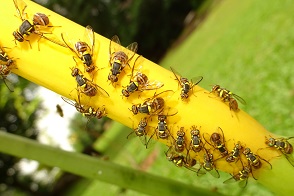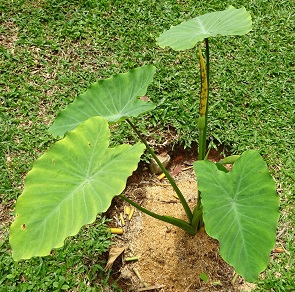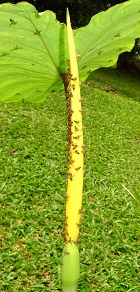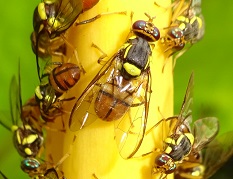| Home | Nature Weekly Index |
24 August 2014 | Oriental Fruit Fly | Taro (Colocasia esculenta)
 The swamp of insects seen on the yellowish surface last weekend were not bees or wasps but fruit flies, Oriental Fruit Fly
(Bactrocera dorsalis) to be exact. I had seen this large fruit fly in the past but never in such a large congregation ---
more than a hundred of them together. The yellow object must be the bait for this huge gathering. In agriculture countries, this
fruit fly is considered to be a very destructive pest of fruits. They deposit their eggs under the skin of host fruits. Once hatched,
the lava help themselves with the fruits, which cause damage to the crops. The fruit-exporting business across continents probably
aids in the spread of this fruit fly. A native to Asia, it has now colonized numerous part
of the world.
The swamp of insects seen on the yellowish surface last weekend were not bees or wasps but fruit flies, Oriental Fruit Fly
(Bactrocera dorsalis) to be exact. I had seen this large fruit fly in the past but never in such a large congregation ---
more than a hundred of them together. The yellow object must be the bait for this huge gathering. In agriculture countries, this
fruit fly is considered to be a very destructive pest of fruits. They deposit their eggs under the skin of host fruits. Once hatched,
the lava help themselves with the fruits, which cause damage to the crops. The fruit-exporting business across continents probably
aids in the spread of this fruit fly. A native to Asia, it has now colonized numerous part
of the world.


 The yellowish surface is actually the spathe, a large bract that enclosed the flower cluster of the
Taro (Colocasia esculenta). Taro is an edible swollen underground stem,
generically known as corm or stem tuber. It is different from root tuber where the swollen underground part arise from the root.
The carrot that we are familiar with is an example of root tuber.
The yellowish surface is actually the spathe, a large bract that enclosed the flower cluster of the
Taro (Colocasia esculenta). Taro is an edible swollen underground stem,
generically known as corm or stem tuber. It is different from root tuber where the swollen underground part arise from the root.
The carrot that we are familiar with is an example of root tuber.
I could not remember when was the last time that I saw a flowering Taro. It had to be many years back since I did not have any picture of the spathe in my file until I encountered this one. The yellow spathe helped in differentiating it from another larger and common Taro plant available locally in the wild, Giant Taro (Alocasia macrorrhizos), which has a shorter greenish-white spathe. Before this sighting of the spathe, I was not too certain whether my Colocasia esculenta pictures should be Alocasia macrorrhizos. I am now more certain that I have got the right Taro identified.
As to why the Oriental Fruit Fly gathered on the spathe of a Taro, I do not have the answer. I would be keen to know whether this was a one time-event or a common occurrence since the flowering of this Taro appeared to be an uncommon event. This particular Taro was planted on high ground and exposed to full sunlight all day long. This may explain its flowering compare to those non-flowering ones that I saw in the past that were usually located in partial shaded area. All the fruit flies were gone when I visited the same plant again yesterday though there was no change to the appearance of the spathe.